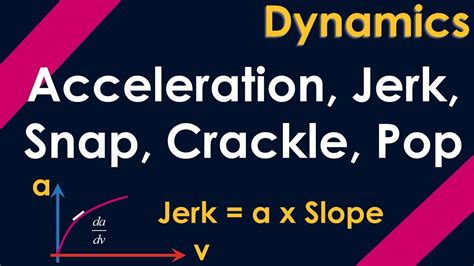In the intricate world of motion, terms like *velocity* and *acceleration* are well understood by most, whether you’re a physics enthusiast or someone who drives daily. However, venture a bit further, and you encounter less familiar terms such as *jerk* and *snap*. These higher derivatives of position may sound like they’re straight out of a breakfast cereal commercial, but they play crucial roles in everyday applications, from the smooth ride of a bus to the precision of engineering machinery.
The hierarchy of derivatives is well-defined: **position**, **velocity**, **acceleration**, **jerk**, **snap**, **crackle**, and **pop**. To those rooted in basic physics or standard engineering, getting beyond acceleration seems perplexing. Yet, integrating these higher derivatives into the design process can lead to innovations that enhance comfort, durability, and efficiency. For instance, in electric buses, the rapid transitions from standstill to acceleration manifest most prominently as jerk. This phenomenon often startles passengers as they struggle to maintain balance.
Understanding these derivatives isn’t just an academic exercise but is vital in practical applications. Consider *N-Body Simulations*, where researchers use jerk and snap to predict and simulate celestial mechanics more accurately. These terms aren’t confined to the stellar realm either. In mechanical engineering, factors such as jerk and snap are critical in preventing wear and tear in machinery. Imagine an automobile camshaft following certain motion dynamics to ensure components don’t disengage due to abrupt changes in acceleration. This is where these higher derivatives come into play.
Moreover, the public transport sector, especially in designing roads and train tracks, relies heavily on smoothing out jerk and snap to offer passengers a comfortable experience. When designing railway tracks or roads, engineers employ transitional curves known as clothoids to mitigate harsh accelerations and induce gradual changes in motion, hence reducing jerk and snap. This is crucial because abrupt changes can lead to discomfort and, in severe cases, accidents. Similarly, roller-coaster designers use these principles to ensure riders experience a thrilling yet smooth ride.
Those working on planetary landing systems, like the Apollo missions, also hinge on these concepts. During the landing, accurate computations involving higher-order derivatives ensure safe descent and touchdown. For instance, continually computing **TGO** (Time-To-Go) combines jerk with current and desired states vectors, refining the thrust vectors and throttle settings. This precision can be the difference between a safe landing and a crash.
Even in our daily lives, these concepts subtly but significantly impact us. Modern vehicle design integrates these principles to offer smoother rides, leading to better comfort and less fatigue for passengers. For instance, self-driving car companies plan routes considering jerk to provide a hassle-free experience. However, it’s a misconception that only humans benefit from this; robots and other automated systems also rely on these principles to ensure longevity and reduce mechanical stress on components.
In essence, while velocity and acceleration are terms that most of us are comfortable with, embracing jerk, snap, and higher derivatives opens up a whole new dimension of possibilities in engineering, transportation, and even space exploration. It’s time to delve deeper, appreciate the unseen forces at play, and recognize the efforts that go into making our rides smoother, our machinery more durable, and our explorations more precise. Embracing these higher derivatives can be seen not just as an academic exercise but as a necessary evolution in the world of motion and mechanics.


Leave a Reply